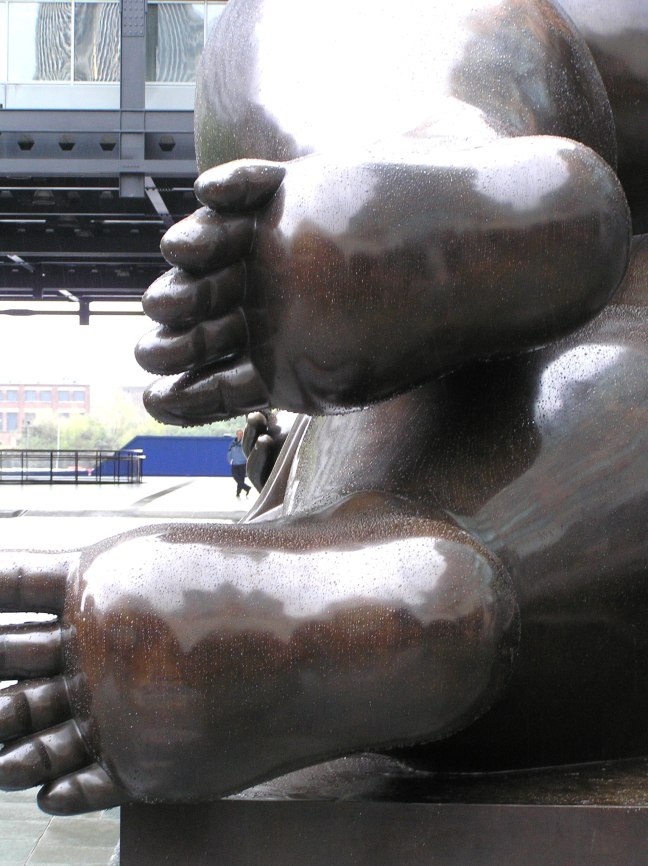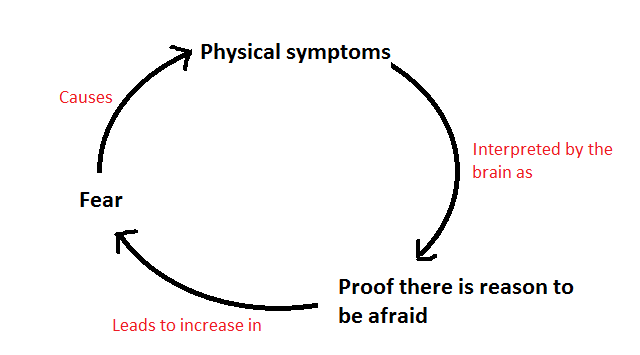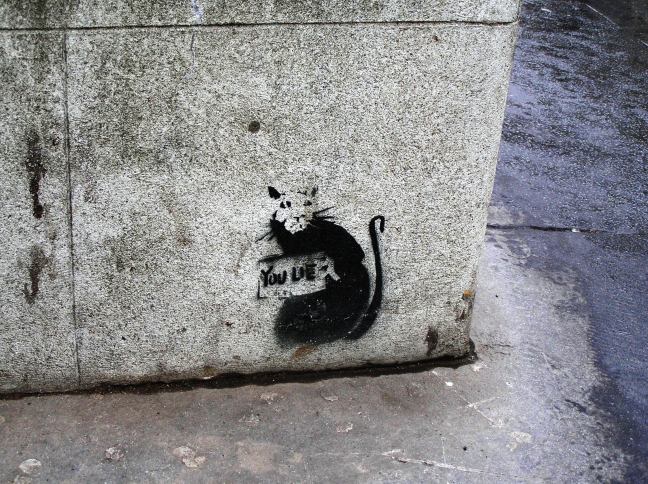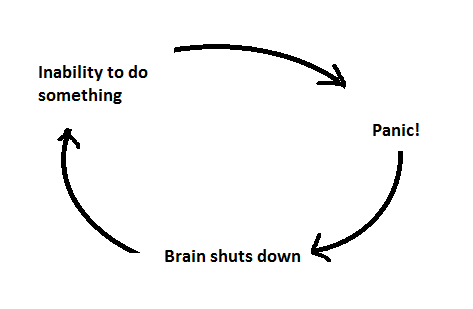Phobias have been found to occur frequently in people with traumatic brain injury (the word ‘traumatic’ here means physical trauma rather than emotional). However, I would guess they can also occur with PTSD as a distortion of triggers.

Note: The below method is a way of dealing with fairly simple phobias and panic, but it’s important that anyone experiencing psychological symptoms from trauma or BI also gets professional help.
Phobias
In the year after the accident I acquired a ridiculous number of phobias. They seemed to appear at random. I became scared of the dark, crossing the road, insects, mice, conversation, sleep, lack of sleep. Some of these phobias I still have a little now, but for the more concrete ones I was able to come up with a method for getting rid of them.
My understanding of how a phobia sticks around is this:
- Usually, an incident causes us to associate danger with the phobia – let’s use Trevor’s phobia of the dark as the result of falling down stairs in the dark, as an example. With a BI, the phobias seem to appear without cause, but the effect is exactly the same – fear associated with specific stimuli.
- Every time afterwards, when Trevor is in the dark, he experiences fear, not just thoughts and emotions, but tangible physical feelings. His heart rate increases, he finds it difficult to breathe, he starts to panic.
- These intense reactions feed into the fear. He becomes more afraid because his body is reacting in an extreme way that is, in itself, scary ie. positive feedback.
- Having experienced the frightening symptoms of terror in 3. while in the dark, his brain (not the conscious bit, but all the automatic processes he has little control over) adds a few new red flags to the idea of ‘dark’ and his phobia grows.
This can also be shown by a nifty diagram

In order to overcome a fear it is necessary to control the physical reaction to it and stop the positive feedback, this means creating new, calm associations with the phobia, to work at its blurry edges.
The Method
So Trevor starts to inch his way into darkness, using the following:
- He stands in a lit room, but at the doorway to a dark room, not scared.
- He breathes slowly, calmly, reassures himself that nothing can happen, the light is right there, he can see fine. He concentrates on the sensations in his feet, his hands; still not scared.
- When he feels completely calm, he takes a step forward into the darkness. He starts to feel a little panic, slight increase in heart rate and speed of breathing.
- So he stops. Repeats 2. until he feels calm again, all the while not moving.
- Repeats 3.
- Repeats 2.
If he reaches a point where he can’t calm himself, then he takes a step back into the light and repeats step 2. It’s important that his final association with the dark is one of calm, this is way more important than getting as close to his fear as possible.
Sometimes this takes a few attempts, and it is a slow way of challenging anything, but it seems to work.
If your phobia is one you can’t physically approach in this way, then there are substitutes. For example: looking at photos of it, reading about it or writing about it. With each of these methods, it is still important to approach the fear slowly, giving yourself time to be calm.
Panic!

It’s also a method that can also be used in a number of other situations when fear and panic take over. Panic is very destructive for people with a BI, because it causes the brain to shut down functions that are already struggling. Whether trying to have a conversation, read a train timetable or cross a busy road, it’s very easy for someone with BI to panic when they find something difficult. This leads to irrational thinking taking over, eg I can’t do this! Why can’t I do this? I can’t do anything! or even I don’t know what’s happening! I’m in danger! But that panic then further shuts down reason and cognitive skills, leading to increased panic – the positive feedback shown above, and shown in the diagram below.

The truth is, you can’t make the BI go away, the difficulties will ease, but it takes time. However you can stop the positive feedback from making the problem worse. This also has the long term benefit of reducing stress, which in turn gives your brain and body the peace they need to heal.
The Method
Whatever it is you’re trying to do, when it starts to get difficult, as long as you’re not in immediate danger, pause for a moment and go through the following steps (this is almost identical to above, but to reiterate…):
- Breathe slowly, calmly.
- Reassure yourself that nothing can happen, you are fine.
- Concentrate on the sensations in your feet, your hands.
- Keep breathing and be aware of your breath.
- When you feel in control, carry on.
Remember it’s ok to find things difficult, and most of the time it’s fine to wait, there’s no danger involved. The danger only comes when panic takes over and you make bad decisions (speaking as someone who has panicked crossing the road and then walked out in front of cars, leading to a phobia about crossing the road!)
Final notes:
This method does not work instantly, it takes time and practice to be able to control panic like this. The best time to start practicing is when you don’t need it and already feel calm.
This method uses techniques I learnt from meditation and mindfulness. Both of those are more difficult and take commitment and are not necessary for this method to work. However, if you can learn them, they are incredibly valuable.
If you have any questions about this, please free to ask in the comments below.

This is a great post! Thank you! In my case (i have anxiety) i found that reassuring myself that nothing would happen didn’t quite work, because the reason i have anxiety in the first place is that i saw that things could, in fact, happen! I found that reassuring myself that yes, something might happen, but no matter what did, it wouldn’t break me; no matter what did happen, i would come out, stronger, on the other side is what made a world of difference. Just presenting a slightly different option for those for whom ,nothing will happen, doesn’t quite work. Thank you for sharing your journey with us!
LikeLiked by 2 people
And thank you for sharing that. I didn’t go into that kind of anxiety (although I know it) but it sounds like you have found a good solution for it. Any additional information is always welcome.
Wishing you continued strength and understanding, my friend.
LikeLiked by 1 person
Thank you! 🙂
LikeLiked by 1 person
What a powerful and helpful article! Great advice! Thank you for sharing this… 🙂
LikeLike
My pleasure, I’m really glad you found it useful. 🙂
LikeLiked by 1 person
Well written and clearly insightful, from not only your personal experiences and and perspectives, but also culled from other sources. And it’s really important to note, as you have done, that anxiety and panic disorders, as caused or influenced by BI as opposed to PTSD are very different – and yes, of course, they do overlap and swim together, at times. But since one is based more on cognitive function as opposed to emotional function, I think it’s important to make the distinction. Certainly though, means and methods for understanding and coping mechanisms cross lines in offering possible solutions and helpful tips 🙂
LikeLiked by 1 person
Thank you, I’m glad you liked it.
I always found it very difficult to distinguish between symptoms caused by the BI and those caused by PTSD. I’m not sure it’s as simple as cognitive and emotional, since both conditions can affect both functions (for me, anyway).
In the end I stopped trying to pick apart the two, but only because it seemed impossible, if you have a greater understanding, I’d really like to hear it. 🙂
I don’t think you’ve really written about this subject, but I wish you would. Your input is always interesting and thought provoking, (even if I don’t completely agree!) 🙂
LikeLiked by 1 person
Well, what struck me right off from the beginning of your post was that you made mention of the difference between what “panic” is when suffering from a BI as opposed to PTSD …. I don’t have the post open before me, so I can’t use the literal note. But I thought “hmmm…. – that’s an excellent point.”
In the case of BI the brain has been affected – physically, literally – where in PTSD – as it is most commonly “applied” today – refers more to an “emotional aftermath” of some circumstance, that may have been physical, but not necessarily affecting the brain/head directly. And I think, this is an important distinction – because PTSD can and would, of course, have cause and effect in both cases, but as you’ve mentioned throughout your articles/posts – BI means that in some significant ways, the brain itself, as matter, mass and “control center” has been affected – physically, and hence, all kinds of “normal” functioning is now, “different.”
A brief example? I suffered a head trauma – and in comparison to you, it is very very minor. But …. yes, certain cognitive aspects of my brain, its “normal functioning” and then, as a consequence, emotional reactions were changed. And after reading your latest post, I can now distinguish with even more clarity, what were PTSD aftershocks of the physical injury – where for months and months the oddest things could/would trigger and I’d behave, respond in an emotional state that prior to the accident, wouldn’t have even been anywhere near my state of “normal.” So, at least, in my mind, there can and most likely are, 2 distinct, if only from a purely technical “analytical” POV versions of PTSD. So, again, I was suffering from PTSD from the actual physical injury – and then, even during and then well after, when things more or less “resumed normally” PTSD from the “traumatic event experience” standpoint also was in operation.
And here’s a key – which you’ve noted in your response. The two overlap – and it becomes near impossible to really understand with absolute precision and clarity where the lines are drawn between the two. And more to the point – well, okay, sure, it can help to know when a panic or anxiety attack is flaring if it’s because of the actual physical trauma – perhaps in knowing that, maybe, with time and efforts to modify this new behaviour/reaction it may be “reasonably handled” – but generally, I think for most people, it becomes far too persnickety. And let’s face it – in the moment – when it’s all playing out – nothing really matters – other than the “fight or flight” response.
So, in essence, I think we are saying, more or less the same thing. There are ever, few, if any real “black white” distinctions …. and sometimes, we just have to work on getting through, and accept, we may never have the answers or completely understand things.
Right … sorry about the running on …. words are clear in my head but seem to want to spill out in all kinds of fashions odd ….
LikeLiked by 2 people
Please don’t be sorry about running on, I’m always interested to hear your viewpoint.
We’re all just trying to make sense of our worlds, and doing so with BI/trauma is so difficult and alien, that I think it’s important for people with experiences to discuss it. Maybe that way we can cobble together some kind of sense. I have learnt a lot from writing these blogs and getting replies from you and others – it is easy to get caught up in my own situation and forget that it’s different for everyone.
You’re absolutely right that we need to accept that we will never completely understand things, and that in the moment, all that matters is keeping safe.
I look forward to seeing more of your wisdom in the future. Have a beautiful rest of weekend. 🙂
(oh and a fine use of the word persnickety! 🙂 )
LikeLiked by 1 person
LOL@ persnickety! (It’s a wonderful word 😀 )
Sharing information and experiences definitely helps – it certainly allows for an expansion of understanding and it helps people feel less alone and isolated. And that’s just it – there is “no one size fits all” – so, we do the best we can.
I hope you have a great week 🙂
LikeLiked by 1 person
Hearing someone else blog about their experience is helpful. I am dealing with an acquired brain injury and didn’t give much thought to some of the side effects. The way you explain some of your experience, I need to acknowledge that I’m dealing with panic attacks and anxiety attacks in various environments. In working with an OT she recommended I get an assessment to get a handle on some of the challenges I was dealing with. The assessment confirmed PTSD symptomology, among some other factors. The brain injury along with a certain level of fear of reinjury, triggered by similar environments that caused the original injury makes it hard to recuperate from it.
The better one understands the various symptoms and behaviours that surface, the better one is able to make accommodations, use techniques such as you outlined above and hopefully be able to monitor improvements and progress.
My injury was the result of a motor vehicle accident despite my extreme vigilance and defensive actions because of stupidity or impatience of a 75 year old driver. Driving invariably puts me into what I subconsciously perceive as a risky environment unless I’m traveling on a divided highway.
I sometimes wonder whether my PTSD symptomology my have been less or non-existent if I had the accident because of recklessness on my part. If it had been recklessness then maybe only when I’m not driving carefully would be perceived as a risky environment. As it is, the environment that recreates the risk is perceived as being outside of my control.
(Thanks for pointing me to your ‘favourite’ blog entry in your recent post.)
LikeLiked by 1 person
Thank you for a thoughtful response. I’m sorry you’ve been going through all that. PTSD and ABI are both such complex and intertwining conditions, in the end I gave up trying to work out what symptom came from which, and how they both originated – although I totally understand the desire to know. It’s true a lack of control can be a factor in PTSD, but doing something stupid that results in a lack of control and injury (as was more the case with me) can have the same affect.
I wrote few blogs on brain injury and PTSD, found under the link TBI and PTSD to the right of the blog, I don’t know if they will be helpful, but maybe…
Also if there is anything I can do to help, if you need to talk or have any questions you have that I might know the answer to ( as someone who’s come out the other side), then please ask. I was recently in contact with a friend of a friend who had suffered a brain injury completely different to mine, but many of the experiences, fears and frustrations were the same, and I think it helped her to have someone to offload on who actually understood what she was talking about.
Anyway, wishing you a peaceful day 🙂
LikeLike